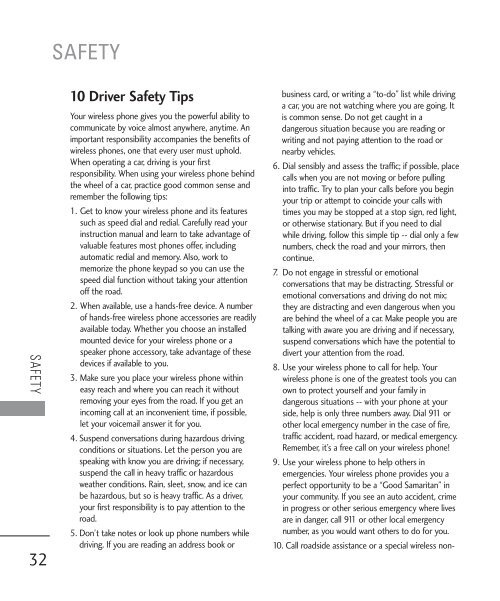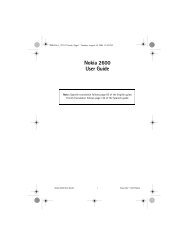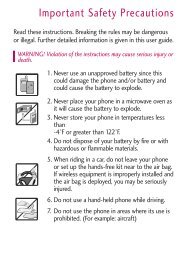Create successful ePaper yourself
Turn your PDF publications into a flip-book with our unique Google optimized e-Paper software.
SAFETY<br />
32<br />
SAFETY<br />
10 Driver Safety Tips<br />
Your wireless phone gives you the powerful ability to<br />
communicate by voice almost anywhere, anytime. An<br />
important responsibility accompanies the benefits of<br />
wireless phones, one that every user must uphold.<br />
When operating a car, driving is your first<br />
responsibility. When using your wireless phone behind<br />
the wheel of a car, practice good common sense and<br />
remember the following tips:<br />
1. Get to know your wireless phone and its features<br />
such as speed dial and redial. Carefully read your<br />
instruction manual and learn to take advantage of<br />
valuable features most phones offer, including<br />
automatic redial and memory. Also, work to<br />
memorize the phone keypad so you can use the<br />
speed dial function without taking your attention<br />
off the road.<br />
2. When available, use a hands-free device. A number<br />
of hands-free wireless phone accessories are readily<br />
available today. Whether you choose an installed<br />
mounted device for your wireless phone or a<br />
speaker phone accessory, take advantage of these<br />
devices if available to you.<br />
3. Make sure you place your wireless phone within<br />
easy reach and where you can reach it without<br />
removing your eyes from the road. If you get an<br />
incoming call at an inconvenient time, if possible,<br />
let your voicemail answer it for you.<br />
4. Suspend conversations during hazardous driving<br />
conditions or situations. Let the person you are<br />
speaking with know you are driving; if necessary,<br />
suspend the call in heavy traffic or hazardous<br />
weather conditions. Rain, sleet, snow, and ice can<br />
be hazardous, but so is heavy traffic. As a driver,<br />
your first responsibility is to pay attention to the<br />
road.<br />
5. Don’t take notes or look up phone numbers while<br />
driving. If you are reading an address book or<br />
business card, or writing a “to-do” list while driving<br />
a car, you are not watching where you are going. It<br />
is common sense. Do not get caught in a<br />
dangerous situation because you are reading or<br />
writing and not paying attention to the road or<br />
nearby vehicles.<br />
6. Dial sensibly and assess the traffic; if possible, place<br />
calls when you are not moving or before pulling<br />
into traffic. Try to plan your calls before you begin<br />
your trip or attempt to coincide your calls with<br />
times you may be stopped at a stop sign, red light,<br />
or otherwise stationary. But if you need to dial<br />
while driving, follow this simple tip -- dial only a few<br />
numbers, check the road and your mirrors, then<br />
continue.<br />
7. Do not engage in stressful or emotional<br />
conversations that may be distracting. Stressful or<br />
emotional conversations and driving do not mix;<br />
they are distracting and even dangerous when you<br />
are behind the wheel of a car. Make people you are<br />
talking with aware you are driving and if necessary,<br />
suspend conversations which have the potential to<br />
divert your attention from the road.<br />
8. Use your wireless phone to call for help. Your<br />
wireless phone is one of the greatest tools you can<br />
own to protect yourself and your family in<br />
dangerous situations -- with your phone at your<br />
side, help is only three numbers away. Dial 911 or<br />
other local emergency number in the case of fire,<br />
traffic accident, road hazard, or medical emergency.<br />
Remember, it’s a free call on your wireless phone!<br />
9. Use your wireless phone to help others in<br />
emergencies. Your wireless phone provides you a<br />
perfect opportunity to be a “Good Samaritan” in<br />
your community. If you see an auto accident, crime<br />
in progress or other serious emergency where lives<br />
are in danger, call 911 or other local emergency<br />
number, as you would want others to do for you.<br />
10. Call roadside assistance or a special wireless non-









